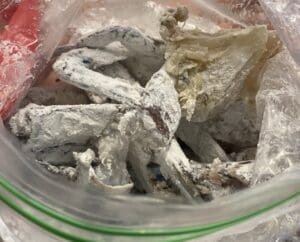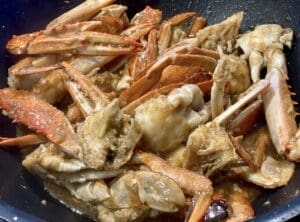
Got some fresh, beautiful crabs? Use them in this classic Ginger Scallion Crab dish for an authentic Chinese experience at home
Growing up with thrifty parents
My sister and I used to get irritated when we were younger because our parents were so frugal. Their priority was saving money for unforeseen circumstances, resulting in them choosing no-frills brands for nearly everything! Hey my Australian friends, do you recall our Franklin supermarkets? My parents stocked our pantry with black and white packaging of no-frill products!!!
We also hardly ate out and if we did, it would be at the cheapest Chinese restaurant they could find. By default, my mum would order my sister and me a plate of fried rice to share. The little 5-year-old budding foodie inside me was mad about this. NO, I don’t want to share and NO; I don’t want to eat fried rice for the rest of my life 😂
‘I want to order that crab dish.’ With that, my parents stared at me silently. ‘No darling, you won’t like it,’ mum said.
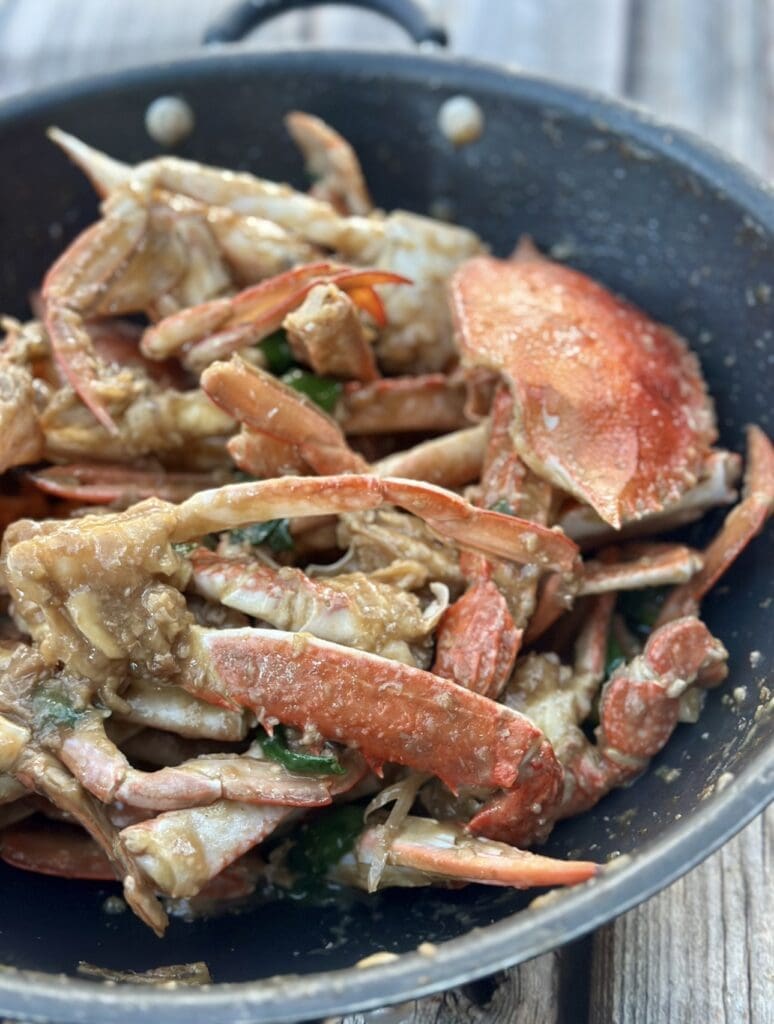
It’s obviously clear now that my parents declined my request because that crab dish wasn’t cheap. Back then, it probably would’ve cost us around $50 and now it’s probably doubled or even tripled in price. Lovely mum ended up buying fresh crabs and making her own version of the classic Chinese-style. You’re always an inspiration, mum! ❤️
So let’s save some dollars and make this mouthwatering crab dish at home. I went looking for giant mud crabs, but I couldn’t go past our iconic Blue Swimmer crabs. They were on the larger side, and also on sale! I bet my thrifty parents would’ve approved!
Ginger Scallion Crab
It’s going to be a messy situation, and we may not appear graceful while extracting as much crab as possible from its shell. But that’s all okay because we are doing in the comfort of our home!
This means we can enjoy every part of the crab, and some may even lick want to lick the shells clean. No names mentioned! Every piece of crab meat we extract feels so rewarding because we work so hard to get it 😂
What does Ginger Scallion crab taste like?
Ginger and scallion is a popular and classic combination found it many Chinese dishes. You’ve likely seen ginger and scallion with lobster, fish or crab. The sauce and spices complement the delicate sweetness of crab perfectly.

How to clean Blue Swimmer Crabs?
Blue swimmer crabs and most kinds of crabs are quite easy to clean and prepare. I’ve previously worked as a fishmonger during my uni days, so I picked up how to clean crabs before cooking. I have a helpful video and post on how to clean and prepare crab.
What crabs are best for Ginger Scallion crab?
Most Chinese restaurants here use mud crab for their Ginger Scallion Crab dish. Mud crabs are much larger, so they are more meaty. Blue crabs or Dungeness crabs are great too because they’re a little easier to handle than those giant mud crabs. Whatever crab you get, the key is sourcing the freshest crabs you can get your hands on. For the best flavour and texture, your crab should either be alive or freshly caught.
Love crab and lobster? So do we!
Ingredients for Ginger Scallion Crab
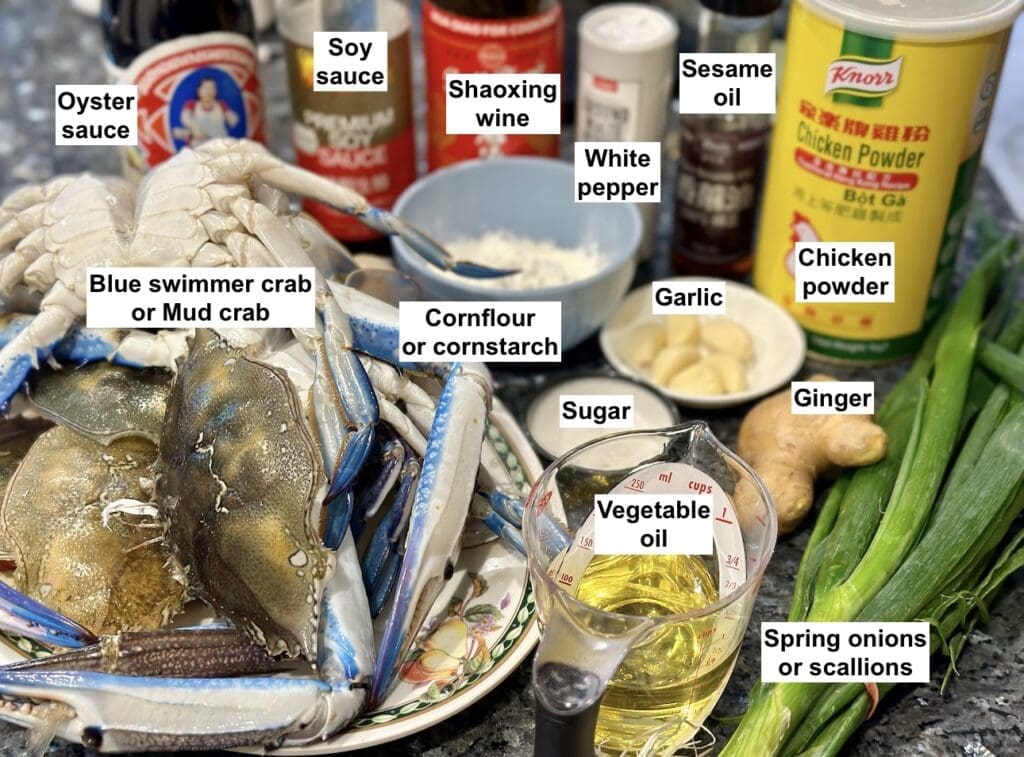
Blue swimmer crabs. – I used fresh local Australian Blue Swimmer Crabs, which are smaller than mud crabs. I used four crabs weighing approximately 500gm / 1.1lb each. You can use any fresh crab, including mud crabs, for this recipe. Check out my post and video on How to Prepare Crabs for the best way to clean them.
Shaoxing cooking wine is a Chinese cooking wine, also referred to as Shao Xing or Shao Hsing. It’s widely used in Chinese cuisine to enhance the flavours of various dishes. Shaoxing cooking wine is made from fermented rice. You can find reasonably priced bottles of Shaoxing wine at Asian specialty stores, and some supermarkets carry them too. Mirin or dry sherry are good substitutes for Shaoxing wine.
Light soy sauce or regular soy sauce are both fine, but dark or sweet soy sauces won’t work since they’re not interchangeable. Light soy sauce is a savoury condiment commonly used in Asian cuisine. It has a rich, umami flavour and is often used as a seasoning or dipping sauce.
Oyster sauce – Despite its name, oyster sauce does not have a strong oyster or fishy flavour. Oyster sauce adds a depth of flavour to dishes and has a rich, savoury and slightly sweet flavour profile. Find oyster sauce by looking in the international section at a supermarket or visit an Asian grocer.
Chicken powder – I cannot live without Knorr Chicken Powder (not sponsored). It seriously enhances the taste in many of my savoury dishes. Although I highly recommend this brand, other chicken powder, chicken stock powder, or crumbled chicken bouillon cubes would also work.
Roasted sesame oil has a strong aroma with a roasted nutty flavour and smell. Sesame oil is available in the international or cooking oil section of supermarkets, or purchased in Asian grocers.
Subscribe to 3CatsFoodie’s FREE Newsletter

For the latest recipes and other fun stuff!
How to make Ginger Scallion Crab
Step-by-step guide with photos

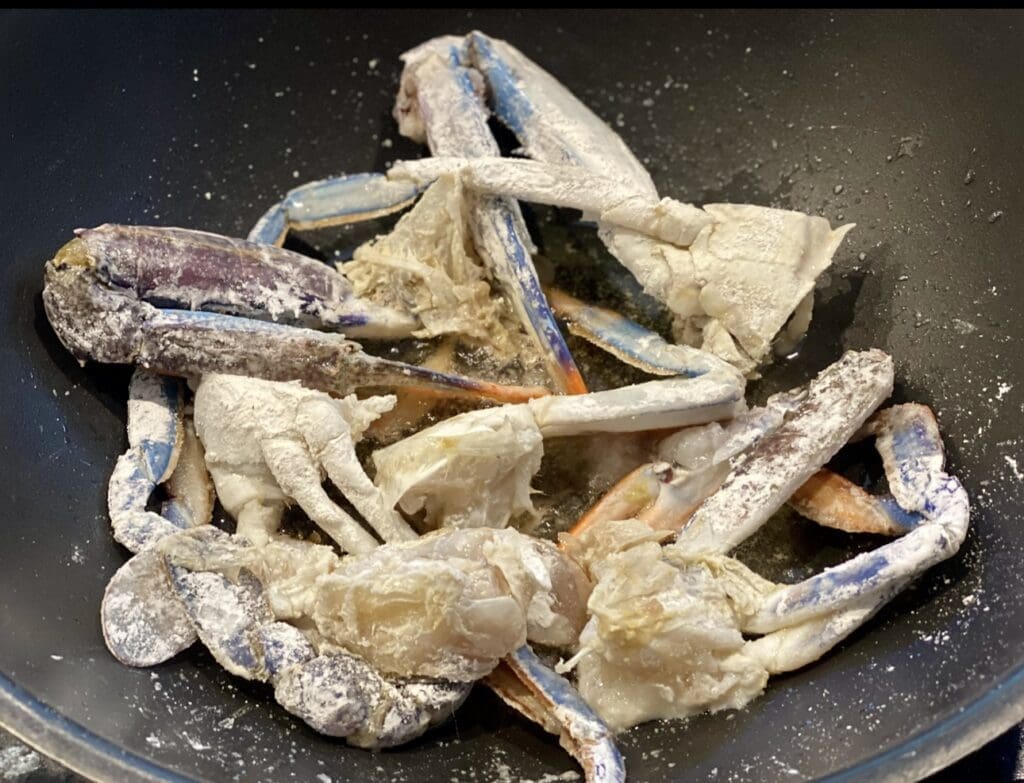

Combine half of the crab and flour in a large sealed plastic snap bag with air. Give the bag a shake to cover all the crab pieces in flour. Repeat this process with the remaining crab and flour.
In a large wok or deep frying pan, pour enough oil to cover the base by 2.5cm / 1in. Heat oil over medium-high heat. The oil is ready when it sizzles when you dip a crab leg in. Fry the crabs until they turn orange on all sides. You may have to do this in batches. Transfer the fried crabs to a large plate.



Remove most of the oil from the wok, leaving just approximately 1 to 2 tablespoons. Heat oil over medium-high heat, then add the garlic and ginger. Saute for 1 to 2 minutes, then add Shaoxing wine, stir for 1 minute. Add soy sauce, oyster sauce and water, then bring mixture to a simmer. Stir in chicken powder, sugar and white pepper, then add in the crab. Carefully stir the crab until it’s coated in sauce, then cover and cook for 3 minutes.
Meanwhile, make a slurry by mixing the flour and water together. Remove the lid from the wok, then pour in the slurry. Gently stir until the sauce has thickened, then add in the spring onions and sesame oil. Cook for a minute, then have a taste, adjust seasoning to your liking if needed. Crab tastes best when served immediately.
I’ve used a third-party application to calculate the calories and nutritional information, so please use this as an approximate guide only.
Cooking measurements are in Australian standard spoon and cup measurements. For specific details and conversions, visit our Australian Cooking Measurements page.
I would love your feedback and support if you made this recipe. To do this, please rate this recipe and provide a comment by scrolling down this page or by clicking that green circle on the bottom left. An email address is required (for spam), but it won’t be published. I would also love to see your dish, so don’t forget to tag me on my Instagram account ‘3catsfoodie’
Cheers – Cat T
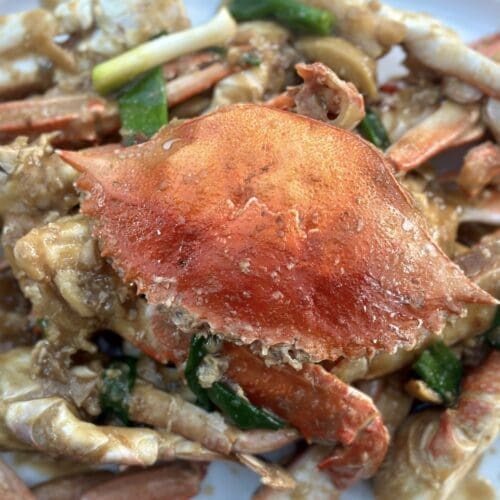
Ginger Scallion Crab (using Blue swimmer crabs)
Video
Ingredients
- 2kg / 4.4lb (or 4 large) Blue swimmer crabs, cleaned cut into quarters (NOTE 1)
- ½ cup (75g / 2.7oz) cornflour or cornstarch
- vegetable or canola oil to fry
- 6 garlic cloves, minced
- 60g / 2oz ginger, sliced thinly
- 3 (110g / 3.8oz) spring onions or scallions, 2.5cm or 1in slices
FOR THE SAUCE
- 1 tbsp (20ml / 0.7floz) oil (use leftover oil from frying)
- 2 tbsp (40ml /1.4floz) Shaoxing wine (NOTE 2)
- ¼ cup (60ml / 2floz) light soy sauce (NOTE 3)
- ¼ cup (60ml / 2floz) oyster sauce (NOTE 4)
- 2 cup (500ml / 17floz) water
- 1 tsp chicken powder (NOTE 5)
- 1 tsp white sugar
- ½ tsp white pepper
- 2 tsp cornflour or cornstarch
- 2 tbsp water (extra for slurry)
- 2 tsp roasted sesame oil (NOTE 6)
Instructions
- Combine half of the crab and flour in a large sealed plastic snap bag with air. Give the bag a shake to cover all the crab pieces in flour. Repeat this process with the remaining crab and flour.

- In a large wok or deep frying pan, pour enough oil to cover the base by 2.5cm / 1in. Heat oil over medium-high heat. The oil is ready when it sizzles when you dip a crab leg in. Fry the crabs until they turn orange on all sides. You may have to do this in batches. Transfer the fried crabs to a large plate.

- Remove most of the oil from the wok, leaving just approximately 1 to 2 tablespoons. Heat oil over medium-high heat, then add the garlic and ginger. Saute for 1 to 2 minutes, then add Shaoxing wine, stir for 1 minute. Add soy sauce, oyster sauce and water, then bring mixture to a simmer. Stir in chicken powder, sugar and white pepper, then add in the crab. Carefully stir the crab until it's coated in sauce, then cover and cook for 3 minutes.

- Meanwhile, make a slurry by mixing the flour and water together. Remove the lid from the wok, then pour in the slurry. Gently stir until the sauce has thickened, then add in the spring onions and sesame oil. Cook for a minute, then have a taste, adjust seasoning to your liking if needed. Crab tastes best when served immediately.






